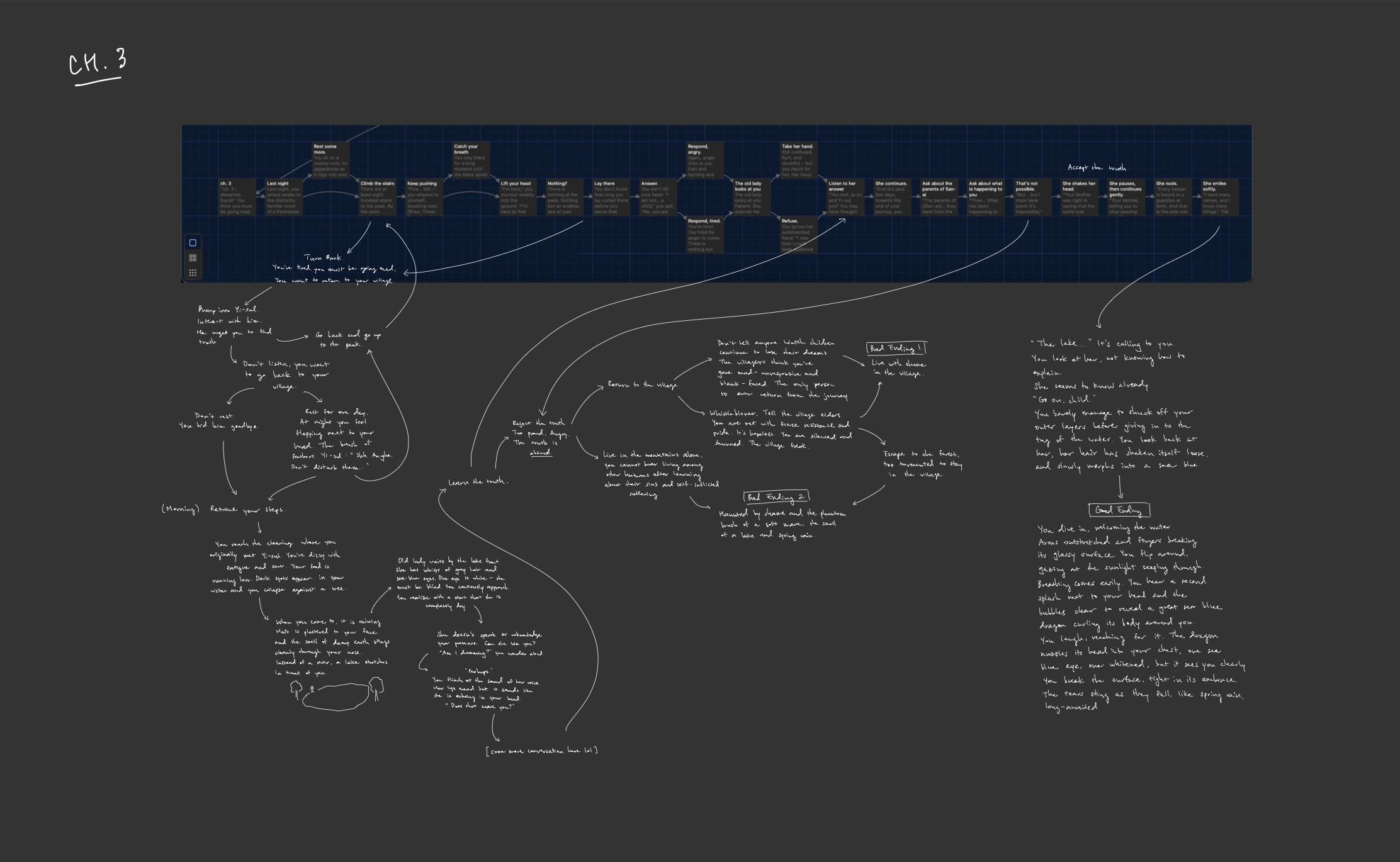
Game Designer: Isabelle Lee
I chose to refine my interactive fiction game from P2.
Hook
The human population has dwindled – only seven small villages scattered at the foot of a mountain remain, with no other civilization in sight.
People called it a plague. Punishment from a higher being, the village Elders had said. Eighty years ago, it swept through the world, silent and merciless, turning life to dust and leaving few survivors.
A curse followed shortly after: the inability to dream.
Play through the eyes of Dan-bi, a young adventurer, who leaves their village to search for the truth and an explanation behind the suffering inflicted on their people. The world is not kind, this much is known, but for reasons that may be darker – and perhaps, simpler – than previously thought.
IF Link
More info on premise + concept and detailed explanation of characters, names and their significance, and terms in P2 Writeup
Updates
- Added graphics and story branding/packaging. See the image at the top of this page and this page for full packaging.
- I wanted to grant the player more agency by adding more branching structure, more player choice (mostly seen in Ch. 3), and multiple endings. In P2, I had only one ending; for P4, I added two more for a total of 1 “good” ending and 2 “bad” endings.
- I started by going back to the drawing board and sketching out my ideas for different choices, paths, and endings.

-
- Overall, my Twine structure changed from looking more linear to something a bit more branching.


- I extended the story at a few points. I added another scene to the segment with Yi-sul in Ch. 2, and then added more to the ending — scenes of Dan-bi settling in the mountain after rejecting the truth, and coming down to the village as well as a timeskip.
- I made better use of Twine by customizing the aesthetic and making it responsive to the story at certain points.
- I used the Twine’s story stylesheet to edit the CSS code and refine the general aesthetic of the game.


-
- I also utilized in-line code to make the passages visually respond to what was written. For example, when the main character is falling, I had conditionals and self-loops to illustrate the sensation of falling; and when the dream that they are in turns black, I had the story background shift to black as well. I provide a preview below.

Playtesting
I conducted two more playtests during the final playtest on 3/16. (I forgot to take pictures 😭)
Playtest 1: Daniel (student)
- Pros
- Concept is thoughtful
- Well-written
- Story is vibrant
- Critiques
- Initially thought I was not taking advantage of Twine functionality but changed his mind after experiencing the way the page responded to his actions (e.g. background turning black, text falling down)
- Need more choices in the beginning still, options were not very different
- The part of figuring out the truth at the end can be a bit more interactive. Have the player “discover” more instead of feeling like they’re simply clicking through the choices.
Playtest 2: Miranda (guest)
- Pros
- Well-written and creative concept
- Felt like she resonated a lot with the story’s message
- Critiques
- Maybe include more details about how the inability to dream affected the village people. Make the stakes higher (e.g. people are depressed, link this with the Mother’s death) to create a greater sense of urgency and disillusionment
- Don’t be afraid to add more drastic turns into the story — thought there was going to be an ending where the protagonist dies on the way up the mountain
Reflection
The main points of feedback from my P2 was that the player did not have enough agency in the chocies they made and that they didn’t feel consequential. This made sense since I struggled a lot with creating a story for a player as opposed to a reader, and the game only had one ending for P2. I felt that I put in some trivial choices for the player to make, just for the sake of giving them choices. I still struggled with a lot of this in P4 — I think the structure and narrative of my story progresses very linearly to build understanding and history, and the majority of the consequential choices come towards the latter half of the last chapter. During the final playtests in class, I received some good feedback from Christina and two of my playtesters of where to insert player choice and not to be too caught up on making everything so obviously consequential (one playtester said that seemingly trivial choices can reveal more about the character and the story, which thus makes it a non-trivial choice).
I would love to continue working on this game and work in more choices in the beginning so that the reader has even more agency over the story. I still have a bit of trouble departing from the idea of “I want the story to end like this” and “I want the events to progress in this order” and succumbing some of my own control to the reader, but I think continuing to work on this story will teach me a lot of good lessons in designing games in general.
I had a lot of fun working on this story and being given the chance to refine it further. Creative writing is something I love doing in my free time, but it’s hard to do during the school year, so I was very grateful for the chance to do it for a class.


